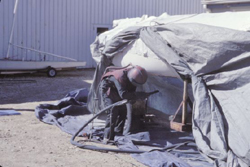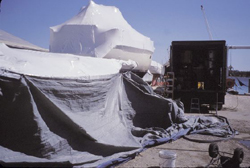New York Sea Grant's
Marina Pollution Prevention Web Site
Section 2: Painting
& Fiberglass Repair
- Abrasive Blasting
Potential Environmental Impacts:
In abrasive blasting, sand, glass or plastic bead, walnut shells,
metal shot or grit, sodium bicarbonate or dry ice  pellets
are used with air pressure or water pressure to remove paint.
Traditional abrasive blasting of large boat hulls with sand and
water can be a messy job resulting in many hundreds of pounds
of spent abrasive mixed with bottom paint. In some cases, this
material may have to be disposed of as a hazardous waste. pellets
are used with air pressure or water pressure to remove paint.
Traditional abrasive blasting of large boat hulls with sand and
water can be a messy job resulting in many hundreds of pounds
of spent abrasive mixed with bottom paint. In some cases, this
material may have to be disposed of as a hazardous waste.
Best
Management Practices:
- Consider alternatives to abrasive blasting on-site, such as dustless
sanders or contracting the work off-site.
- If abrasive
blasting must be done, perform it within well-ventilated spray
booths or plastic tarp enclosures away from
 the
water to minimize the spreading of dust and windblown material,
and to prevent residue from being carried into surface waters. the
water to minimize the spreading of dust and windblown material,
and to prevent residue from being carried into surface waters.
- If tarp enclosures
are used, avoid blasting on windy days. Because tarps are not
rigid, they do not eliminate wind flow through the blasting area,
and so they allow the wind to carry blasting material and residue
into surface waters.
- Prohibit uncontained
blasting in the marina.
- Store spent
sandblasting grit, scrapings and debris under cover in a manner
that minimizes contact with process water or storm water.
- Where possible
try to use media that can be recovered and reused or media that
can be separated more easily from the paint chips to minimize
the amount of hazardous waste produced by blasting. (For examples
of companies that specialize in different types of media and associated
equipment, click
here.)
Regulatory
Issues:
- Abrasive blasting waste can be either hazardous or non-hazardous,
depending upon the levels of contaminants it contains (the most
common contaminants are metals and other materials associated
with the paints). In order to determine which is the case, the
generator must either have their waste tested or utilize reliable
"knowledge of process" information for the waste (if
available) [40 CFR 262.11, click
here].
- Such information could include testing by haulers, or studies
by industry trade groups. For more information on New York
hazardous waste testing requirements, click
here.
- If they are hazardous, they must be managed in accordance with
hazardous waste storage requirements [40 CFR 262.11],
click
here.
- For more information on New York's Hazardous Waste Regulations
and storage requirements, click
here.
- If there is
a stormwater discharge from your facility and you blast or store
the used blast media outdoors, you may have to register for a
General Permit for the Discharge of Storm Water Associated with
Industrial Activity ("Storm Water General Permit").
For more information on stormwater permitting in New York,
click
here.
- Perform abrasive
blasting so that visible emissions do not cross outside of the
property boundary or cause a nuisance.
|

